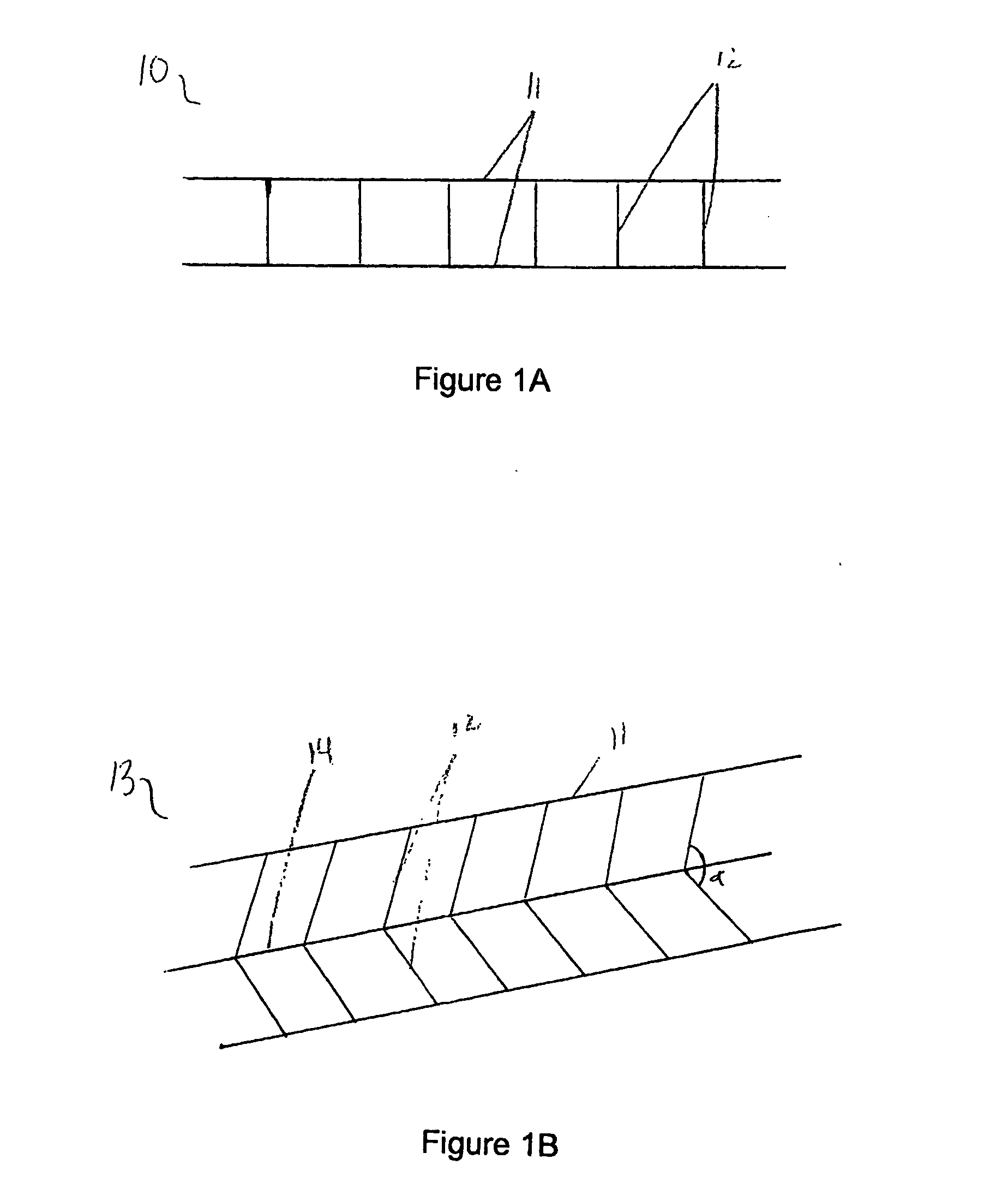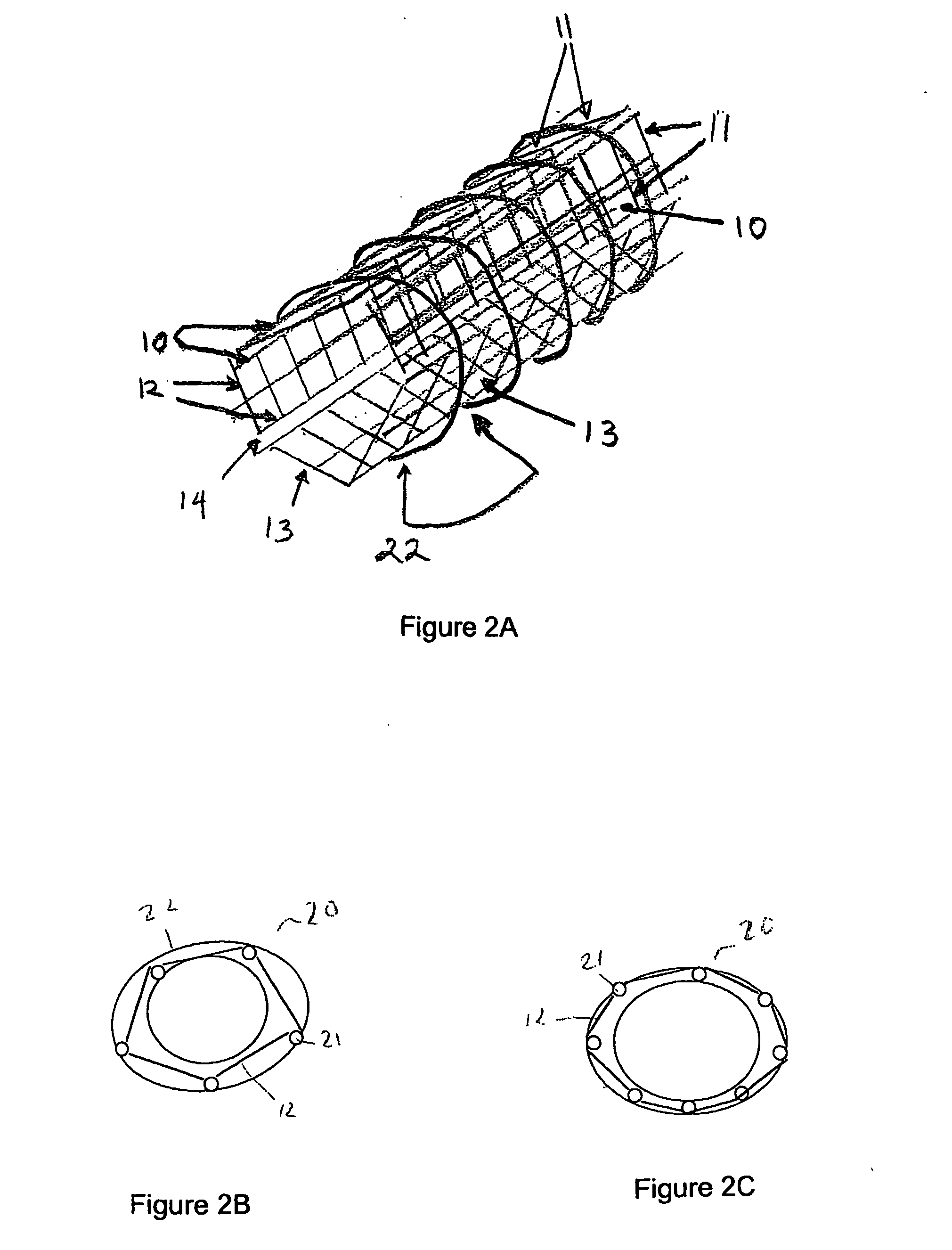Artificial vessel scaffold and artifical organs therefrom
- Summary
- Abstract
- Description
- Claims
- Application Information
AI Technical Summary
Benefits of technology
Problems solved by technology
Method used
Image
Examples
example i
Fabrication of an Artificial Vessel Scaffold
[0080] As depicted in FIG. 1A, a panel 10 is formed by connecting two or more, preferably two or three, parallel strands 11 of nonabsorbable material, preferably non-immunogenic, with minimal elastic potential, for example, #10 nylon fibers, with shorter, perpendicular strands 12 of the same diameter material. Perpendicular strands 12 are spaced approximately 0.5 to 1.0 μM apart and are oriented at approximately 90° to parallel strands 11. All strands are fixedly connected to one another by means appropriate for the selected material. Such means include, but are not limited to, heat and adhesive. For example, high temperatures induce the binding capability and anneal certain fibers such as SILASTIC™, or microscopic amounts of sealant substances such as silicone, polyurethane, or polyethylene can permanently join such fibers as would be used in the present invention.
[0081] In the embodiment illustrated in FIG. 1A, the panel is shown as ha...
example ii
Fabrication of a Bioartificial Vascular Device
[0088] Prior to implanting a prosthetic vessel as described above, vascular endothelial cells and vascular smooth muscle cells must be grown upon a permanent structure. This process begins with fabrication of an artificial vessel scaffold, optionally scaffold 20 according to Example I. A layer of vascular smooth muscle cells is grown along the outer surface of scaffold 20. A layer of endothelial cells is grown along the inner surface of scaffold 20. The addition of cellular layers can be accomplished by placing scaffold 20 in a vascular cell growth chamber 30, as shown in FIG. 3, so that scaffold 20 forms an outer chamber 31 and an inner chamber 32 of vascular cell growth chamber 30. Outer chamber 31 is filled with a cell culture solution containing vascular smooth muscle cells and incubated to allow the cells to attach to the outer surface of scaffold 20, approximately two days.
[0089] Following the deposit of an outer layer of cells, ...
example iii
Fabrication of an Internal Bioartificial Hepatic Organ
[0099]FIG. 6A shows a schematic overview of an artificial internal hepatic organ unit 60. A common entry portion 61 of artificial internal hepatic organ unit 60 is sutured to an abdominal artery (not shown). Common entry portion 61 has an inner diameter of approximately 2 cm and a length of approximately 1 to 2 cm. Extending from the end of common entry portion 61 opposite the artery are a plurality of 2-20 individual entry portions 62. Each individual entry portion 62 has a diameter of about 80-100 μm. Each individual entry portion 62 leads to the first end of a plurality of 4-8 inner vessels 63, each having an inner diameter of about 30-50 μm and a length of 8-12 cm. The plurality of inner vessels 63 originating from one individual entry portion 62 join at their second end to an individual exit portion 64. The individual exit portion 64 has a diameter of about 80-100 μm. Each individual exit portion 64 is joined together at a ...
PUM
 Login to View More
Login to View More Abstract
Description
Claims
Application Information
 Login to View More
Login to View More - R&D
- Intellectual Property
- Life Sciences
- Materials
- Tech Scout
- Unparalleled Data Quality
- Higher Quality Content
- 60% Fewer Hallucinations
Browse by: Latest US Patents, China's latest patents, Technical Efficacy Thesaurus, Application Domain, Technology Topic, Popular Technical Reports.
© 2025 PatSnap. All rights reserved.Legal|Privacy policy|Modern Slavery Act Transparency Statement|Sitemap|About US| Contact US: help@patsnap.com



